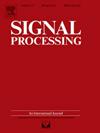MPR与直角坐标在TDOA定位中的分析与比较
IF 3.4
2区 工程技术
Q2 ENGINEERING, ELECTRICAL & ELECTRONIC
引用次数: 0
摘要
修正极坐标表示(MPR)为近场和远场场景下的点定位和测向提供了统一的数学框架。虽然已有研究表明MPR可以缓解距离阈值效应,即当源移动超过临界距离时定位精度突然下降,但仍然缺乏严格的理论解释和与笛卡尔表示(CR)的全面比较。分析了已知和未知信号传播速度(SPS)下MPR和CR在基于到达时间差(TDOA)的定位中的优点和局限性。虽然先前Wang和Ho(2017)已经研究了已知sps情景下的cram本文章由计算机程序翻译,如有差异,请以英文原文为准。
On the analysis and comparison between MPR and cartesian for TDOA localization
Modified polar representation (MPR) provides a unified mathematical framework for both point localization and direction finding in near-field and far-field scenarios. Although prior research has shown that MPR alleviates the range thresholding effect, which refers to the sudden degradation in localization accuracy when the source moves beyond a critical distance, a rigorous theoretical explanation and comprehensive comparison with the Cartesian representation (CR) are still lacking. This paper analyzes the advantages and limitations of MPR and CR for time difference of arrival (TDOA)-based localization under both known and unknown signal propagation speeds (SPS). While the Cramér–Rao lower bound (CRLB) and hybrid Bhattacharyya–Barankin bound (HBBB) have been studied previously for known-SPS scenarios in Wang and Ho (2017), we derive and analyze the HBBB under the unknown-SPS setting. HBBB provides a tighter analytical evaluation beyond the CRLB, so it can quantify the thresholding effect when the source is distant or noise is high. Furthermore, an analytical comparison based on the Hessian of the maximum likelihood (ML) cost function is performed to reveal why MPR is more noise-robust in far-field conditions, whereas CR performs better in the near field—findings supported by the HBBB. Additionally, the far-field case is investigated, establishing the equivalence of MPR with the conventional far-field model in estimating both angles and SPS. These results enhance the theoretical understanding of MPR and underscore its practical implications for localization and sensing applications.
求助全文
通过发布文献求助,成功后即可免费获取论文全文。
去求助
来源期刊

Signal Processing
工程技术-工程:电子与电气
CiteScore
9.20
自引率
9.10%
发文量
309
审稿时长
41 days
期刊介绍:
Signal Processing incorporates all aspects of the theory and practice of signal processing. It features original research work, tutorial and review articles, and accounts of practical developments. It is intended for a rapid dissemination of knowledge and experience to engineers and scientists working in the research, development or practical application of signal processing.
Subject areas covered by the journal include: Signal Theory; Stochastic Processes; Detection and Estimation; Spectral Analysis; Filtering; Signal Processing Systems; Software Developments; Image Processing; Pattern Recognition; Optical Signal Processing; Digital Signal Processing; Multi-dimensional Signal Processing; Communication Signal Processing; Biomedical Signal Processing; Geophysical and Astrophysical Signal Processing; Earth Resources Signal Processing; Acoustic and Vibration Signal Processing; Data Processing; Remote Sensing; Signal Processing Technology; Radar Signal Processing; Sonar Signal Processing; Industrial Applications; New Applications.
 求助内容:
求助内容: 应助结果提醒方式:
应助结果提醒方式:


